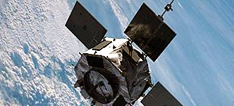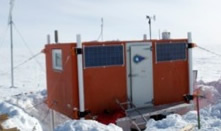Projects
1) The Polar Engineering Development Center (PEDC)
The PEDC, housed at NJIT and run as a joint venture between NJIT, Siena College, and the University of New Hampshire, is a highly skilled group of collegiate professors, research scientists, electrical and mechanical engineers, and technicians that have decades of experience in instrument and hardware design for deployment at high latitude/polar environments. The group was originally formed in the 1980’s as part of the NSF-supported Automatic Geophysical Observatory program which operates to this day across the Antarctic ice shelf. Today, the PEDC serves the broader scientific communities conducting research in polar environments by providing support in the areas of sustainable “green” power generation in the 100-W range, power conditioning and control, robust engineering for polar climates, data acquisition units and transmission services, and general polar field support. Below is a sampling of projects that active at the PEDC.
Automatic Geophysical Observatories (AGOs)
The AGOs are a collection of remote, unmanned platforms for geophysical monitoring on the Antarctic plateau. Figure 1 shows an AGO enclosure and Figure 2 shows the active AGO locations. Each AGO site has a fiberglass shelter approximately 5-m x 2.5-m x 2.5-m in size to house scientific instruments and basic living accommodations (used for biennium site visits). These sites currently use a totally “green” renewable energy scheme (i.e., solar and wind) to power a suite of scientific and communications equipment at a level of approximately 100-W year-round. After several years of experimentation and modification, the unmanned facility has become highly reliable.
Iridium SBD Data Acquisition and Transmission Systems (IDAT)
A completely new telemetry system (Figure 3) using Iridium SBD was designed, implemented and deployed at all of the AGO sites. The Iridium SBD data service allows small, low-power modems (called “mobile units”) to send multiple data packets, each of up to 350 bytes long, to a stateside e-mail address or IP address. This data link is highly reliable, error-free and available with world-wide coverage. The present IDAT design accommodates 16 analog channels with 12-bit resolution. Four digital channels are provided which are opto-isolated. When taking a measurement, +/-15 V is available at the front panel. Because the SBD data communications are two-way, the IDAT systems can control a latching relay or send a serial data packet to an instrument when commanded from stateside. These systems are ideal for remote instrument monitoring and synoptic data transfer.
South Pole, Antarctica, Solar Radio Telescope (SPASRT)
The PEDC is currently involved with the development, construction, installation, and testing of a solar radio telescope at South Pole station for 24-hour continuous, long-term austral summer observations of the sun across the 0.5-18 GHz frequency band. The radio telescope design is mature and based on similar radio telescopes currently in use (Figure 4). The receiver will make use of recent technological advances in digital technologies to simultaneously cover the 0.5-18 GHz band. The SPASRT system will utilize two sets of 9 parallel IF channels, each of 2000 MHz instantaneous bandwidth, to permit dual-polarization sampling of the entire 0.5-18 GHz range without frequency or polarization switching. The RF signal from the dual polarization feed would be transmitted directly to a warm control room via optical fiber, and then downconverted and filtered into 9 bands that are simultaneously sampled on each polarization with multiple ADCs. The entire system is designed to withstand the difficult operating conditions of the South Pole and to operate autonomously during the austral summer season.
2) The Second-generation Optimized Fabry-Perot Doppler Imager (SOFDI)
Gerrard is responsible for the deployment and operation of the SOFDI, which is a novel triple-etalon Fabry-Perot designed for 24-hour observations of thermospheric and mesospheric winds and temperatures. This is a one-of-a-kind instrument capable of taking daytime thermospheric wind measurements; a unique and difficult measurement important to equatorial thermospheric physics. Concurrently, Gerrard is working with an all-sky imager from Cornell University [CASI] that will be used in conjunction with SOFDI to observe mesospheric gravity waves and thermospheric plasma irregularities. Gerrard is also working on a number of related numerical modeling projects; notably the development of the community-accessible FOREGRATS model which tracks the generation and propagation of tropospherically-generated and secondary in-situ generated gravity waves. The SOFDI measurements, the all-sky imager data from CASI, and the FOREGRATS modeling efforts are all being brought together to synergistically support the Air Force C/NOFS program that will study and forecast the occurrence of equatorial spread-F [ESF]; a high priority “hot topic” research issue in the fields of space weather and plasma physics. To this end, Gerrard is currently the PI of an AFOSR-sponsored multi-university campaign involving Clemson University, Cornell University, and the University of Illinois at Urbana-Champaign that has implemented instruments across South America, with the flagship instrument being SOFDI at Huancayo, Peru, to study ESF.
3) NJIT-UACNJ-PSU Collaborative
Gerrard initiated and leads the NJIT-UACNJ-PSU collaborative, a multi-institutional endeavor involving NJIT, The Pennsylvania State University, Clemson University, and the United Astronomy Clubs of New Jersey [UACNJ] focused on the operation of the ITEK 1.2-m fully-steerable optical telescope to the UACNJ field site at Jenny Jump State Forrest in northwestern New Jersey. This telescope is the largest optical telescope located east of the Mississippi and is open to the public for sponsored viewing. Furthermore, this telescope forms the receiver of a lidar system and is the heart of the research facility. Gerrard’s initial research focuses on the study of gravity wave generation by the Newark-New York urban heat island [UHI] convective pattern; a unique and novel research program addressing urbanization and its role in global climate change. The lidar instrument is accompanied by a Fabry-Perot Interferometer, a dual-frequency GPS receiver, a magnetometer, and solar radio telescope support instrumentation to support the UHI-gravity wave studies, as well as to provide spin-off space weather research projects. Senior Personnel include: Observatory Director Mr. Gilbert Jeffer [NJIT-UACNJ], Distinguished Professor Dr. Dale Gary [NJIT], Dr. Robert Melville [NJIT], Professor Dr. Timothy Kane [Penn State], Professor Dr. John Meriwether [Clemson University], Professor Dr. Jonathan Makela [UIUC], and Dr. David Fritts [CoRA].


